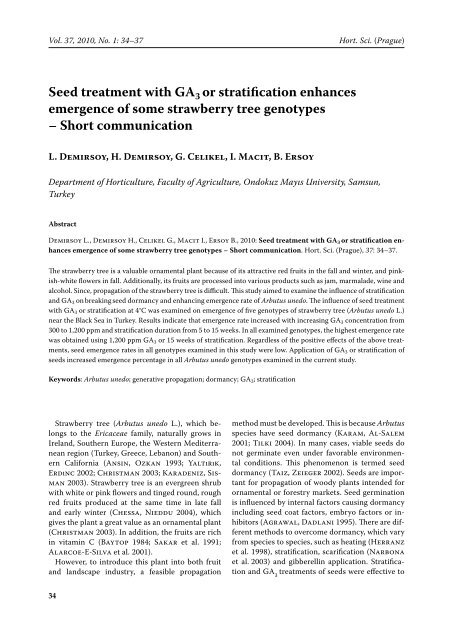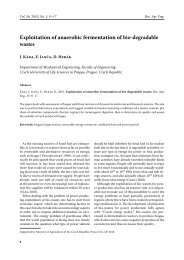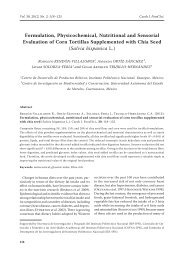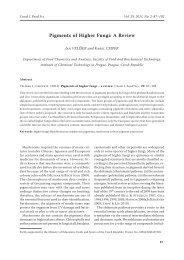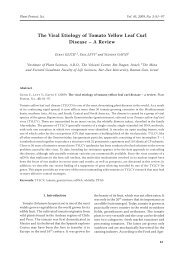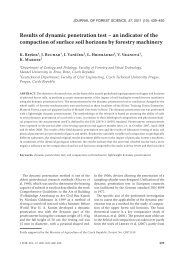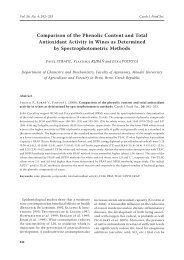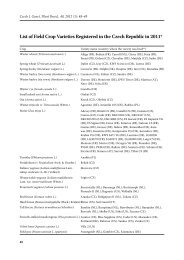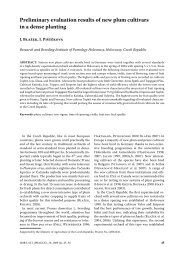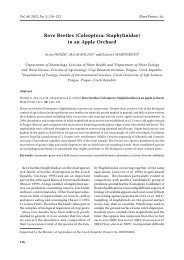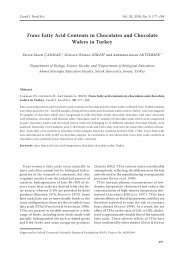Seed treatment with GA3 or stratification enhances emergence of ...
Seed treatment with GA3 or stratification enhances emergence of ...
Seed treatment with GA3 or stratification enhances emergence of ...
You also want an ePaper? Increase the reach of your titles
YUMPU automatically turns print PDFs into web optimized ePapers that Google loves.
Vol. 37, 2010, No. 1: 34–37 H<strong>or</strong>t. Sci. (Prague)<br />
<strong>Seed</strong> <strong>treatment</strong> <strong>with</strong> <strong>GA3</strong> <strong>or</strong> <strong>stratification</strong> <strong>enhances</strong><br />
<strong>emergence</strong> <strong>of</strong> some strawberry tree genotypes<br />
– Sh<strong>or</strong>t communication<br />
L. Demirsoy, H. Demirsoy, G. Celikel, I. Macit, B. Ersoy<br />
Department <strong>of</strong> H<strong>or</strong>ticulture, Faculty <strong>of</strong> Agriculture, Ondokuz Mayıs University, Samsun,<br />
Turkey<br />
Abstract<br />
Demirsoy L., Demirsoy H., Celikel G., Macit I., Ersoy B., 2010: <strong>Seed</strong> <strong>treatment</strong> <strong>with</strong> <strong>GA3</strong> <strong>or</strong> <strong>stratification</strong> <strong>enhances</strong><br />
<strong>emergence</strong> <strong>of</strong> some strawberry tree genotypes – Sh<strong>or</strong>t communication. H<strong>or</strong>t. Sci. (Prague), 37: 34–37.<br />
The strawberry tree is a valuable <strong>or</strong>namental plant because <strong>of</strong> its attractive red fruits in the fall and winter, and pinkish-white<br />
flowers in fall. Additionally, its fruits are processed into various products such as jam, marmalade, wine and<br />
alcohol. Since, propagation <strong>of</strong> the strawberry tree is difficult. This study aimed to examine the influence <strong>of</strong> <strong>stratification</strong><br />
and <strong>GA3</strong> on breaking seed d<strong>or</strong>mancy and enhancing <strong>emergence</strong> rate <strong>of</strong> Arbutus unedo. The influence <strong>of</strong> seed <strong>treatment</strong><br />
<strong>with</strong> <strong>GA3</strong> <strong>or</strong> <strong>stratification</strong> at 4°C was examined on <strong>emergence</strong> <strong>of</strong> five genotypes <strong>of</strong> strawberry tree (Arbutus unedo L.)<br />
near the Black Sea in Turkey. Results indicate that <strong>emergence</strong> rate increased <strong>with</strong> increasing <strong>GA3</strong> concentration from<br />
300 to 1,200 ppm and <strong>stratification</strong> duration from 5 to 15 weeks. In all examined genotypes, the highest <strong>emergence</strong> rate<br />
was obtained using 1,200 ppm <strong>GA3</strong> <strong>or</strong> 15 weeks <strong>of</strong> <strong>stratification</strong>. Regardless <strong>of</strong> the positive effects <strong>of</strong> the above <strong>treatment</strong>s,<br />
seed <strong>emergence</strong> rates in all genotypes examined in this study were low. Application <strong>of</strong> <strong>GA3</strong> <strong>or</strong> <strong>stratification</strong> <strong>of</strong><br />
seeds increased <strong>emergence</strong> percentage in all Arbutus unedo genotypes examined in the current study.<br />
Keyw<strong>or</strong>ds: Arbutus unedo; generative propagation; d<strong>or</strong>mancy; <strong>GA3</strong>; <strong>stratification</strong><br />
Strawberry tree (Arbutus unedo L.), which belongs<br />
to the Ericaceae family, naturally grows in<br />
Ireland, Southern Europe, the Western Mediterranean<br />
region (Turkey, Greece, Lebanon) and Southern<br />
Calif<strong>or</strong>nia (Ansin, Ozkan 1993; Yaltırık,<br />
Erdınc 2002; Christman 2003; Karadeniz, Sisman<br />
2003). Strawberry tree is an evergreen shrub<br />
<strong>with</strong> white <strong>or</strong> pink flowers and tinged round, rough<br />
red fruits produced at the same time in late fall<br />
and early winter (Chessa, Nieddu 2004), which<br />
gives the plant a great value as an <strong>or</strong>namental plant<br />
(Christman 2003). In addition, the fruits are rich<br />
in vitamin C (Baytop 1984; Sakar et al. 1991;<br />
Alarcoe-E-Silva et al. 2001).<br />
However, to introduce this plant into both fruit<br />
and landscape industry, a feasible propagation<br />
34<br />
method must be developed. This is because Arbutus<br />
species have seed d<strong>or</strong>mancy (Karam, Al-Salem<br />
2001; Tilki 2004). In many cases, viable seeds do<br />
not germinate even under fav<strong>or</strong>able environmental<br />
conditions. This phenomenon is termed seed<br />
d<strong>or</strong>mancy (Taiz, Zeieger 2002). <strong>Seed</strong>s are imp<strong>or</strong>tant<br />
f<strong>or</strong> propagation <strong>of</strong> woody plants intended f<strong>or</strong><br />
<strong>or</strong>namental <strong>or</strong> f<strong>or</strong>estry markets. <strong>Seed</strong> germination<br />
is influenced by internal fact<strong>or</strong>s causing d<strong>or</strong>mancy<br />
including seed coat fact<strong>or</strong>s, embryo fact<strong>or</strong>s <strong>or</strong> inhibit<strong>or</strong>s<br />
(Agrawal, Dadlani 1995). There are different<br />
methods to overcome d<strong>or</strong>mancy, which vary<br />
from species to species, such as heating (Herranz<br />
et al. 1998), <strong>stratification</strong>, scarification (Narbona<br />
et al. 2003) and gibberellin application. Stratification<br />
and GA 3 <strong>treatment</strong>s <strong>of</strong> seeds were effective to
H<strong>or</strong>t. Sci. (Prague) Vol. 37, 2010, No. 1: 34–37<br />
break d<strong>or</strong>mancy and increase seed germination<br />
in some Arbutus species (Roy 1974; Karam, Al-<br />
Salem 2001). Although some w<strong>or</strong>k was done on<br />
breaking seed d<strong>or</strong>mancy in species such as Arbutus<br />
andrachne L. and Arbutus menziesii (Kose 1998;<br />
Karam, Al-Salem 2001; Harrington, Kraft<br />
2004), less data are available f<strong>or</strong> Arbutus unedo<br />
(Kose 1998; Tilki 2004). The aim <strong>of</strong> this study was<br />
to examine the effect <strong>of</strong> <strong>stratification</strong> and GA 3 on<br />
breaking seed d<strong>or</strong>mancy and enhancing <strong>emergence</strong><br />
<strong>of</strong> Arbutus unedo.<br />
Table 1. Emergence (%) in different genotypes <strong>of</strong> Arbutus unedo L. as affected by <strong>treatment</strong> <strong>of</strong> seeds <strong>with</strong> different<br />
concentration <strong>of</strong> GA 3<br />
Concentration<br />
MAtErIALS AnD MEtHoDS<br />
Mature fruits were collected in November 2005<br />
from five genotypes (57A01, 57A02, 57A07, 57A15<br />
and 57A22) growing in the natural habitat. These<br />
were genotypes selected by a selection program<br />
from the native strawberry tree population grown<br />
in the Central Black Sea Region <strong>of</strong> Turkey (Celikel<br />
et al. 2008). To separate seeds from fruits, fruits<br />
were soaked in water f<strong>or</strong> 1 day to s<strong>of</strong>ten pulp and<br />
they were rubbed between fingers to separate seeds<br />
from pulp. The seeds were washed and air dried f<strong>or</strong><br />
2 days. The viability tests were made on four representative<br />
samples including 25 seeds each by the<br />
2,3,5-tri-phenyl-tetrazolium method (Ista 1993).<br />
The seeds were soaked in water f<strong>or</strong> 24 h, and the<br />
seed coat was removed. The seeds were then soaked<br />
in a 1% solution 2,3,5-tri-phenyl-tetrazolium chl<strong>or</strong>ide<br />
f<strong>or</strong> 24 h at 24°C in an incubat<strong>or</strong>. The seeds<br />
were bisected longitudinally and examined under a<br />
microscope. <strong>Seed</strong>s <strong>with</strong> embryos stained red were<br />
considered viable. In the current study, seeds <strong>of</strong> all<br />
genotypes exhibited 100% viability.<br />
Two experiments were conducted to determine<br />
the effects <strong>of</strong> GA 3 application and <strong>stratification</strong><br />
on seed d<strong>or</strong>mancy breaking and <strong>emergence</strong>. The<br />
GA 3 experiment was carried out on four geno-<br />
Genotype<br />
57A1 57A2 57A7 57A22<br />
Control 1.06 d * 1.00 d 2.05 d 3.25 d<br />
300 ppm 2.07 c 2.00 c 7.15 c 11.00 c<br />
600 ppm 4.10 b 4.05 b 14.25 b 16.50 b<br />
1,200 ppm 6.00 a 13.05 a 25.00 a 34.75 a<br />
*means followed by different letters <strong>with</strong>in columns differ significantly (P < 0.05)<br />
types (57A01, 57A02, 57A07 and 57A22). <strong>Seed</strong>s<br />
were soaked in 10 ml GA 3 solutions at 300, 600 <strong>or</strong><br />
1,200 ppm f<strong>or</strong> 24 h. <strong>Seed</strong>s in the control <strong>treatment</strong><br />
were soaked in 10 ml water. The <strong>stratification</strong> experiment<br />
was carried out on all genotypes. The<br />
seeds were mixed <strong>with</strong> moist perlite and put in a<br />
small plastic cup in a refrigerat<strong>or</strong> at 4°C f<strong>or</strong> 5 <strong>or</strong><br />
15 weeks. <strong>Seed</strong>s in the control were not subjected<br />
to low temperature. In both experiments, the seeds<br />
were sown in seed trays filled <strong>with</strong> a mixture <strong>of</strong><br />
1 perlite:1 peat (v/v) and were placed in a growth<br />
room at 24°C under continuous light. One gram<br />
per liter methyl 1-(butylcarbamoyl)-2-benzimidazole<br />
carbamate (benomyl) solution was inc<strong>or</strong>p<strong>or</strong>ated<br />
into the perlite-peat mixture and fine perlite<br />
used f<strong>or</strong> <strong>stratification</strong>. Emergence was rec<strong>or</strong>ded<br />
during 60 days.<br />
F<strong>or</strong> each experiment, <strong>treatment</strong>s were arranged<br />
in a completely randomized design <strong>with</strong> four replicates<br />
per <strong>treatment</strong> and 25 seeds per replicate. Data<br />
f<strong>or</strong> each experiment were subjected to analysis <strong>of</strong><br />
variance (ANOVA) using SAS (Statistical Analysis<br />
System, 1995, SAS Institute, Cary, N.C.). Duncan’s<br />
multiple range test was used to compare means.<br />
Emergence percentages were transf<strong>or</strong>med by arcsin<br />
pri<strong>or</strong> to analysis.<br />
rESuLtS AnD DISCuSSIon<br />
GA 3 application: GA 3 improved <strong>emergence</strong> (Table<br />
1). Emergence rate increased <strong>with</strong> increasing<br />
GA 3 concentration. Some researches suggested<br />
that GA 3 may substitute f<strong>or</strong> cold <strong>stratification</strong> and<br />
rep<strong>or</strong>ted that GA 3 increased the germination percentage<br />
<strong>of</strong> A. andrachne and A. unedo (Kose 1998;<br />
Karam, Al-Salem 2001; Tilki 2004). Kose (1998)<br />
rep<strong>or</strong>ted a high germination percentage in A. unedo<br />
seeds treated <strong>with</strong> 400 ppm GA 3 . Karam and<br />
Al-Salem (2001) also indicated that <strong>treatment</strong> <strong>of</strong><br />
35
Vol. 37, 2010, No. 1: 34–37 H<strong>or</strong>t. Sci. (Prague)<br />
Table 2. Emergence (%) in different genotypes <strong>of</strong> Arbutus unedo L. as affected by duration <strong>of</strong> seed <strong>stratification</strong><br />
Stratification duration<br />
36<br />
Genotypes<br />
57A1 57A2 57A7 57A15 57A22<br />
Control 0.00 c * 0.00 c 0.00 c 0.00 c 0.00 c<br />
5 weeks 7.43 b 17.25 b 23.75 b 4.15 b 2.00 b<br />
15 weeks 17.20 a 20.25 a 42.50 a 30.80 a 19.75 a<br />
*means followed by different letters <strong>with</strong>in columns differ significantly (P < 0.05)<br />
A. andrachne seeds <strong>with</strong> 250 <strong>or</strong> 500 ppm GA 3 was<br />
successful in breaking d<strong>or</strong>mancy and resulted in<br />
83–86% germination. Furtherm<strong>or</strong>e, Tilki (2004)<br />
rep<strong>or</strong>ted that <strong>treatment</strong> <strong>of</strong> A. unedo seeds <strong>with</strong><br />
300, 600 <strong>or</strong> 900 ppm GA 3 improved germination<br />
percentage and the highest was 84% using 300 ppm<br />
GA 3 . Among the genotypes tested, the highest<br />
<strong>emergence</strong> rate was obtained from 57A22 (34.75%<br />
in 1,200 ppm) while the lowest <strong>emergence</strong> rate was<br />
obtained from 57A2 and 57A1 (1.00 and 1.06% in<br />
control, respectively).<br />
Stratification application: There was no <strong>emergence</strong><br />
<strong>of</strong> seeds that were not subjected to <strong>stratification</strong><br />
(Table 2), although the seeds were viable, which<br />
indicates that the seeds were d<strong>or</strong>mant. Increasing<br />
<strong>stratification</strong> duration increased <strong>emergence</strong> rate<br />
f<strong>or</strong> all genotypes. Karam and Al-Salem (2001)<br />
noticed that increasing cold <strong>stratification</strong> duration<br />
resulted in a significant increase in germination<br />
percentage in A. andrachne, <strong>with</strong> 12 <strong>or</strong> 16 weeks<br />
resulting in 86% <strong>or</strong> 87% germination, respectively.<br />
Harrington and Kraft (2004) obtained 87%<br />
germination after 40-day cold <strong>stratification</strong> and<br />
lower than 2% <strong>with</strong>out <strong>stratification</strong> in A. menziesii.<br />
Tilki (2004) also found a significant increase in<br />
germination percentage in A. unedo <strong>with</strong> increasing<br />
duration <strong>of</strong> cold <strong>stratification</strong>, and stated that<br />
there was no significant difference in germination<br />
percentage between 9 (86%) and 16 (84%) weeks <strong>of</strong><br />
<strong>stratification</strong>. It was rep<strong>or</strong>ted that Arbutus seeds<br />
require 4–6 weeks <strong>of</strong> <strong>stratification</strong> (Huxley et al.<br />
1992). In the current study, the highest <strong>emergence</strong><br />
percentage (42.50%) was obtained when seeds <strong>of</strong><br />
genotype 57A7 were stratified f<strong>or</strong> 15 weeks.<br />
Application <strong>of</strong> GA 3 <strong>or</strong> <strong>stratification</strong> <strong>of</strong> seeds increased<br />
<strong>emergence</strong> percentage in all A. unedo<br />
genotypes examined in the current study although<br />
it was low compared to the result <strong>of</strong> other studies<br />
(Karam, Al-Salem 2001; Tilki 2004), which may<br />
be due to the response <strong>emergence</strong> rate evaluated in<br />
our study compared to germination percentage <strong>or</strong><br />
due to differences in genotypes used.<br />
r e f e r e n c e s<br />
Agrawal P.K., Dadlani M., 1995. Techniques in <strong>Seed</strong> Science<br />
and Technology. 2 nd Ed. India, South Asian Publishers<br />
Limited: 179.<br />
Alarcoe-E-Silva M.L.C.M.M., Leitao A.E.B., Azinheira<br />
H.G., Leitao M.C.A., 2001. The Arbutus berry: Studies on<br />
its col<strong>or</strong> and chemical characteristics at two mature stages.<br />
Journal <strong>of</strong> Food Composition and Analyses, 14: 27–35.<br />
Ansin R., Ozkan C., 1993. Tohumlu Bitkiler (Fenerogam).<br />
Trabzon, K.T.Ü. Orman Fak. Yayınları: 512.<br />
Baytop T., 1984. Türkiye’de Bitkiler ile Tedavi (Therapy by<br />
Plants in Turkey). İstanbul, İ.Ü.Yayınları: 520.<br />
Celikel G., Demirsoy L., Demirsoy H., 2008. The strawberry<br />
tree (Arbutus unedo L.) selection in Turkey. Scientia<br />
H<strong>or</strong>ticulturae, 118: 115–119.<br />
Chessa I., Nieddu G., 2004. Description <strong>of</strong> the Strawberry Tree.<br />
Available at: http://www3.unifi.it/ueresgen29/ds9.htm<br />
Christman S., 2003. Arbutus unedo. Available at: http://<br />
www.fl<strong>or</strong>idata.com/ref/A/arbu_une.cfm<br />
Harrington C.A., Kraft J.M., 2004. Cold <strong>stratification</strong> <strong>of</strong><br />
pacific madrone seeds. Native-Plant-Journal, 1: 66–74.<br />
Herranz J.M., Ferrandis P., Martinez-Sanchez J.J., 1998.<br />
Influence <strong>of</strong> heat on seed germination <strong>of</strong> seven Mediterranean<br />
Leguminosae species. Vegetatio, 136: 95–103.<br />
Huxley A., Griffiths M., Levy M., 1992. The New Royal<br />
H<strong>or</strong>ticultural Society Dictionary <strong>of</strong> Gardening. London,<br />
The Macmillan Press, Ltd.<br />
Ista, 1993. International rules f<strong>or</strong> seed testing. <strong>Seed</strong> Science<br />
and Technology, 21: 160–186.<br />
Karadeniz T., Sisman T., 2003. Giresun’da yetiştirilen bir<br />
kocayemiş (Arbutus unedo L.) tipinde biyolojik özellikler<br />
(The biological characteristics <strong>of</strong> a type <strong>of</strong> strawberry<br />
tree grown in Giresun in Turkey). Ulusal Kivi ve Üzümsü<br />
Meyveler Semp: 47–49.<br />
Karam N.S., Al-Salem M.M., 2001. Breaking d<strong>or</strong>mancy in<br />
Arbutus andrachne L. seeds by <strong>stratification</strong> and gibberellic<br />
acid. <strong>Seed</strong> Science and Technology, 1: 51–56.<br />
Kose H., 1998. Studies on the germination <strong>of</strong> some woody<br />
<strong>or</strong>nemental plants existing in Turkish Fl<strong>or</strong>a. 1. Arbutus<br />
unedo L. and Arbutus andrachne L. Anadolu. Journal <strong>of</strong><br />
Aegean Agricultural Research Istitute, 8: 55–65.
H<strong>or</strong>t. Sci. (Prague) Vol. 37, 2010, No. 1: 34–37<br />
Narbona E., Arista M., Ortiz P.L., 2003. <strong>Seed</strong> germination<br />
<strong>of</strong> Arbutus unedo L. (Ericaceae). Acta Botanica Malacitana,<br />
28: 73–78.<br />
Roy D.F., 1974. Arbutus menziesii Pursh. (Pasific Madrone).<br />
In: <strong>Seed</strong> <strong>of</strong> Woody Plants in the United States. Washington,<br />
USDA.<br />
Sakar M.K., Berkman M.Z., Cals I., Ruedý P., 1991. Constituents<br />
<strong>of</strong> Arbutus andrachne. Fitoterapia, 62: 176–177.<br />
C<strong>or</strong>responding auth<strong>or</strong>:<br />
Assoc. Pr<strong>of</strong>. Dr. Hüsnü Demirsoy, Ondokuz Mayıs University, Faculty <strong>of</strong> Agriculture,<br />
Department <strong>of</strong> H<strong>or</strong>ticulture, 55139-Samsun, Turkey<br />
phone: + 90 362 312 1919, fax: + 90 362 457 6034, e-mail: husnud@omu.edu.tr<br />
Taiz L., Zeieger E., 2002. Plant Physiology. 3 rd Ed. USA,<br />
Sinauer Associates, Inc.: 544–546.<br />
Tilki F., 2004. Improvement in seed germination <strong>of</strong> Arbutus<br />
unedo L. Pakistan Journal <strong>of</strong> Biological Sciences, 7:<br />
1640–1642.<br />
Yaltırık T., Erdınc S., 2002. Trees. Istanbul, The Foundation<br />
<strong>of</strong> Challenge <strong>with</strong> Erosion, F<strong>or</strong>estation and Protection <strong>of</strong><br />
Natural Resources <strong>of</strong> Turkey: 32.<br />
Received f<strong>or</strong> publication April 30, 2009<br />
Accepted after c<strong>or</strong>rections November 23, 2009<br />
37


